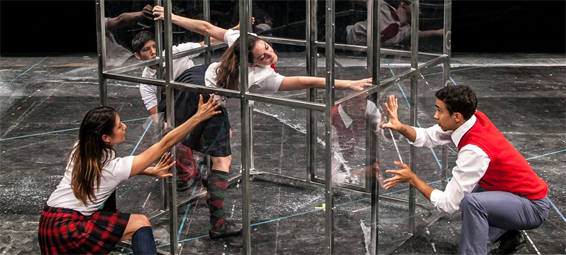Each year the Meadows presents a performance at the Winspear Opera House to help raise funds for scholarships for SMU Meadows and the Meadows Scholars Program. And while the program always offers an exicting evening of dance, this year’s program included additional intrigue a new commission of The Rite of Spring marking the 100th anniversary of the music’s composition and controversial debut.
The evening’s program last week enlisted the talents of four choreographers’: George Balanchine, Adam Hougland, Danny Buraczesky, and Joost Vrouenraets; the Meadows Symphony Orchestra accompanied all four dances this evening under the direction of maestro Paul Phillips. The program opened with Valse-Fantasie, choreographed by George Balanchine in 1967, to the passionate music of Glinka. This technically demanding piece encapsulated the rhythm, melody and structure of the music. Soloists, Aubry Neal and Alex Druzbanski, manage to make it through the performance, despite the fact they were visibly and audibly exhausted only half way through. In contrast, the four demi-soloists were swift and light on their feet, appropriately elegant, displayed impeccably musical timing and truly delightful to watch.
Watershed, a quiet, unassuming, contemporary ballet, choreographed by Adam Hougland in 2006 as part of Julliard’s centennial celebration and re-staged for this concert, was beautifully executed by dancers Raven Ross and Dexter Green. Hougland has set several breathtaking works on the SMU dancers over the years. He is a rare talent, and we are fortunate to have him here as artist-in-residence.
An SMU Meadows concert would not be complete without the inclusion of something from the jazz dance genre. Enter Danny Buraczesky. For the next 15 minutes, we were transported to 1940’s dance scene from Leonard Burnstien’s On the Town set against the Dallas Arts District skyline of 2013. His dancers were very well rehearsed, their energy never wavered, and they held attention for the duration of the piece.
An entire book could be written about the second half of the evening, The Rite of Spring, commissioned by award winning guest choreographer Joost Vrouenraets from the Netherlands. Honoring the hundred year anniversary of the original The Rite of Spring, Joost was tasked with creating an entirely new ballet. Inspired by a “new generation grappling with beautifully seductive yet dangerous violence – economic, cultural, and socio-political – that is the hallmark of the 21stcentury they will inherit.”
His visualization manifests on a stage occupied by several large and small green houses, set against a dark stripped down stage. These green houses are manipulated by the dancers, who climb in them, push them around the stage, turn the houses around, pull them apart, and line them up. The stage props suggest a semiotic relationship between the dancers and the houses which both nourishes the group and imprisons them, with the exception of the “chosen one,” played by Julie Kay, whose individualism empowers her to break free of the “cult”ure.
The dance itself is a smart collection of repetition and accumulation building into a near frenzy. (Costumer, Eugenia P. Stallings dressed the men in red pants with white shirts, and the girls in dark plaid skirts, white button down tops, and dark knee-high socks.) The dancers rise and fall, their arms flinging about to the heavy-percussive pulse of Stravinsky’s Rite of Spring. On the surface, viewers can take in the roughly executed, heady dancing as violent, decadent, but the wild and provocative solos, duets, trios, and group movement phrases begin to tell a story of vulnerability outside the collective, of group think, and we see clearly the individual is the smallest minority. Dancers break into convulsive movement, arms, legs, torsos echoing in angular responses. Suddenly, there was a pause, the music stopped, the entire cast stood silent and in a line, at the edge of the stage staring out into the audience for what felt like an eternity.
In the final part of The Rite of Spring we are introduced to a strange little golden puppet that seems to be searching for someone to procreate with. One after another he violently rejects offers from women in the collective. He sets his sights on “the chosen one” who inevitably rejects him. She climbs into the green house, sheds her uniform and collects a mass of energy from a shower of water now drenching the interior of the green house. When she emerges, soaking wet and simulating nudity (but really dressed in nude colored underwear), Julie Kay breaks out in a riveting solo where her agile athleticism is put to the service of starkly stylized isolations with edgy, angular movements punctuated by breath, humanity, and electrifying physicality. The collective suddenly realize the freedom that comes with breaking from group-think, however, it’s too late for them, only “the chosen one,” the individual, survives. Somewhere out there Ayn Rand is giving this performance a standing ovation.
Photo via





